Suji Ka Halwa | Sheera Recipe
The most classic halwa preparation across the Indian subcontinent is Suji Ka Halwa – made with fine semolina (suji/rava), sugar, ghee, nuts, and flavored with cardamom powder. While this is the delicious North Indian version, in Maharashtra it’s known as Sheera. This easy recipe comes together in just 15 minutes and is a family heirloom we’ve been making for decades during get-togethers, festivals, and special occasions.
What Is Suji Halwa? (And Why It’s So Loved)
Suji Ka Halwa is a traditional Indian dessert made by roasting semolina (suji or rava) in ghee, then cooking it with water or milk, sugar, and cardamom. Soft, rich, and fragrant, it’s a dish that brings both comfort and celebration – often made as prasad, served during festivals, or simply enjoyed as a sweet snack.
For me, this halwa is deeply nostalgic. I still remember the bowls of warm suji halwa served in temples as prasad, the aroma mingling with incense. During Ganesh Chaturthi festival in Mumbai, we’d relish sheera served with devotion in little leaf bowls at pandals.

Over the years, I slowly learned the fine nuances that make a great halwa – how much to roast the suji, when exactly to pour in the water, and how ghee transforms the texture into something truly melt-in-the-mouth. It’s these small details that turn a simple recipe into a lifelong favorite.
Known by Many Names Across India
Suji Ka Halwa is enjoyed across India under different names, each with its own regional identity and subtle variations — though the base ingredients remain the same: suji (semolina), ghee, sugar, and water.
- Rava Sheera – Known by this name in Maharashtra and Western India. This recipe, as listed here, is the Sheera recipe made with water. Some families may use milk instead, but both are common.
- Rava Kesari – A vibrant South Indian variation, often colored with saffron or food-grade color and sometimes made with milk for richness.
- Sajjige – Karnataka’s version, often served as temple prasad — simple and soulful.
- Kesari Bath – A soft, saffron-tinged sweet halwa from Karnataka, often served alongside Khara Bath (a spiced Upma) as part of the popular Chow Chow Bath breakfast combo.
No matter what it’s called, this semolina sweet holds a timeless place in Indian cuisine; from temple offerings to festive feasts.
You can explore more delightful variations in my Halwa Recipes Collection.
The Perfect Ratio for Sheera
Suji Ka Halwa is often made in large quantities for religious events. For best results, follow this base proportion:
Suji : Sugar : Water : Ghee = 1 : 1 : 2 : ½
However, I adjust this slightly for a balanced taste:
- Sugar: I use ⅔ or ¾ cup sugar for 1 cup suji, depending on how sweet I want it. Using 1 cup sugar makes it very sweet.
- Ghee: I add about ⅔ cup ghee, which I find sufficient. You can adjust as per preference.
- Water: I use 2.5 cups water for a pudding-like texture, though 2 cups also work. Adjust based on your preferred consistency and suji type.
This version makes a soft, melt-in-the-mouth halwa that’s perfect as a snack, dessert, or even served with puri.
When and Why to Make Suji Ka Halwa
Suji halwa is that rare dish which fits just about every occasion:
- Festivals like Diwali, Ganesh Chaturthi, or Navratri
- Religious Ceremonies – as naivedyam or prasad
- Everyday moments – as a quick dessert or sweet breakfast
During Navami pooja in Navratri, this halwa is traditionally served with kala chana and Poori to young girls (kanjak), symbolizing the Mother Goddess. It’s one of those comforting, auspicious sweets that never go out of style – and you honestly don’t need a special reason to enjoy it.
Making Suji Ka Halwa – The Traditional Way
Roast The Suji Until Aromatic
1. Heat ⅓ cup ghee in a kadai or a thick bottomed pan. Keep the heat to a low or medium-low. Use a heavy pan to cut down on the risk of burnt suji.
Keep ⅓ cup sugar and 1.25 cups water to boil in a pan on a different burner, while the ghee heats up. You can check the section ‘Making sugar syrup’ for this.
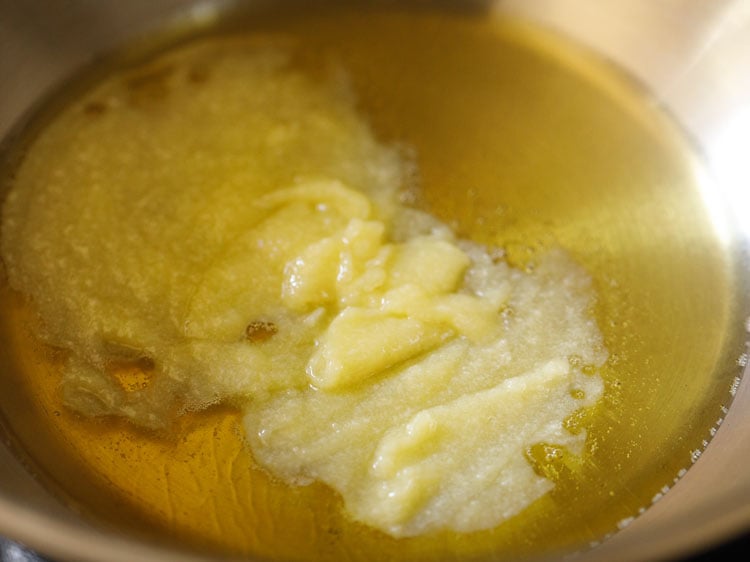
2. Add ½ cup suji (rava or semolina). Use a fine variety of suji and not the coarser variety.
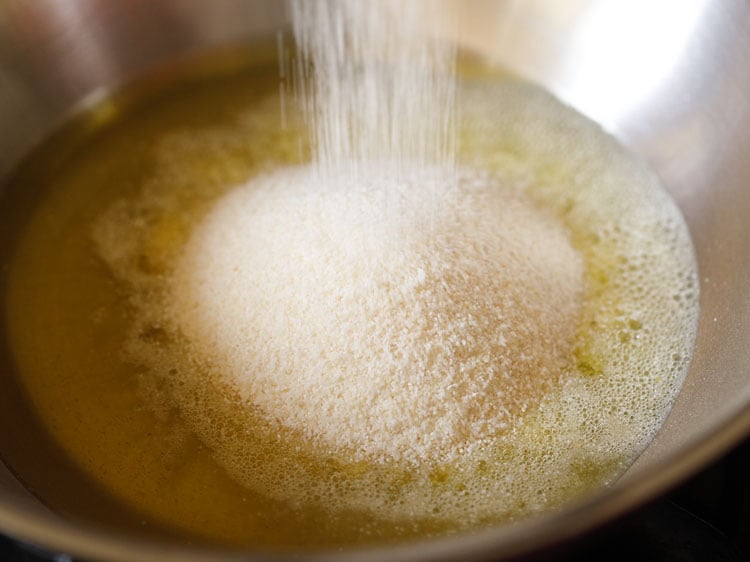
3. Also, add 10 to 12 halved or whole cashews.

4. Mix well and start roasting the suji and cashews.
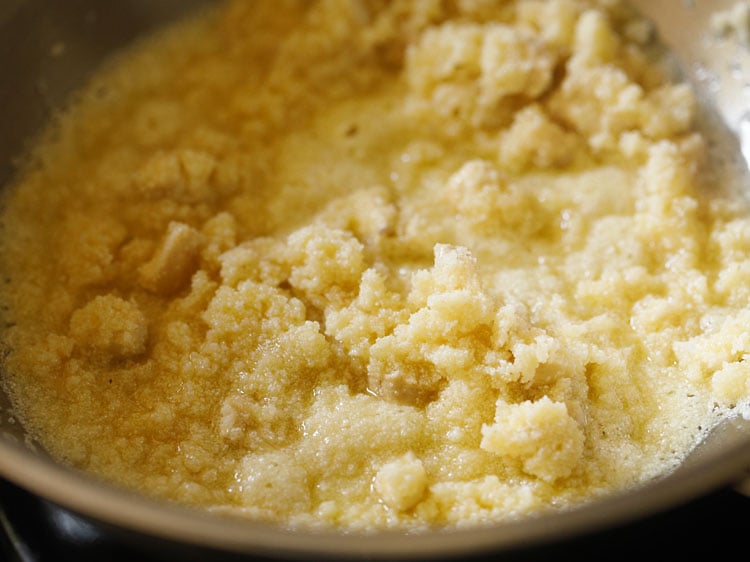
5. Stir the suji continuously, so that the grains do not stick to the pan. This way, you can evenly roast the suji too.
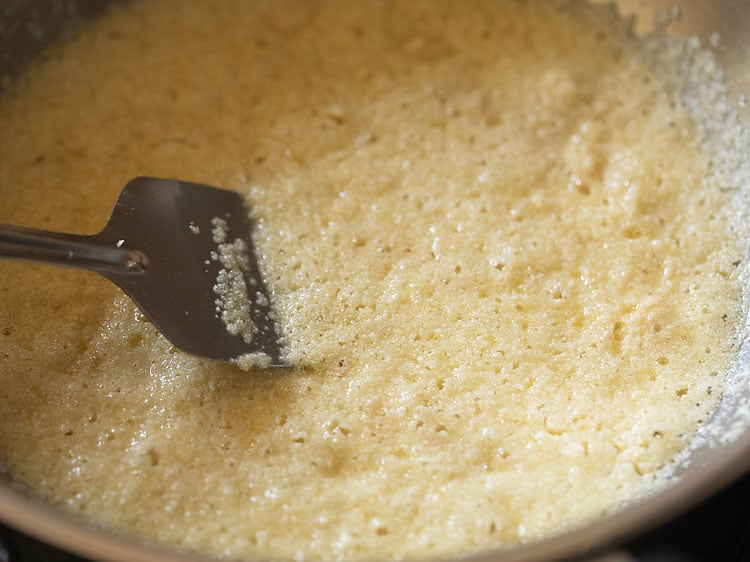
6. You have to roast the suji till the ghee separates and cashews turn golden. The color of the suji or rava should not become brown. There will also be a fragrant of suji and ghee in your kitchen.
Roasting suji takes 7 to 8 minutes approximately, on low heat. Without roasting the suji well, you will not get the perfect texture in the halwa. There will be a slight raw taste in the halwa. So, this step is important.
Tip: The suji fries well, by the time the cashews turn golden. So, keep stirring and wait for the cashews to get golden.
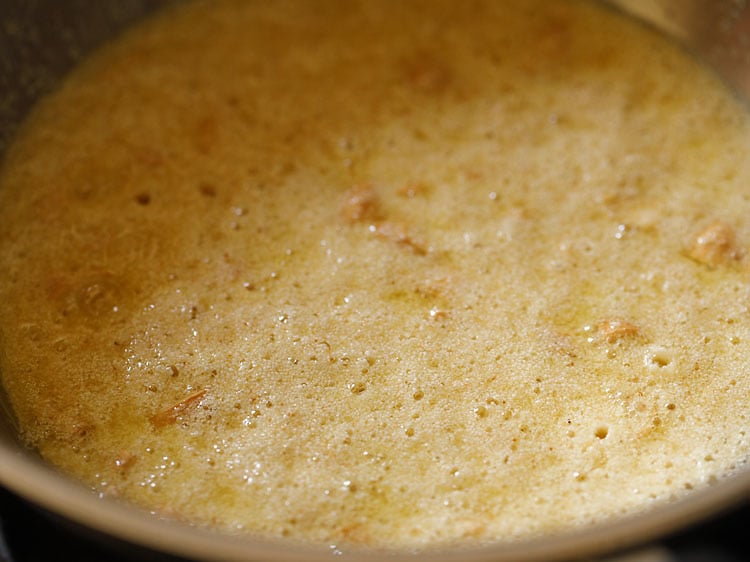
7. Next, add 1 teaspoon chironji (optional), 2 tablespoons golden raisins and a pinch of edible camphor (optional).
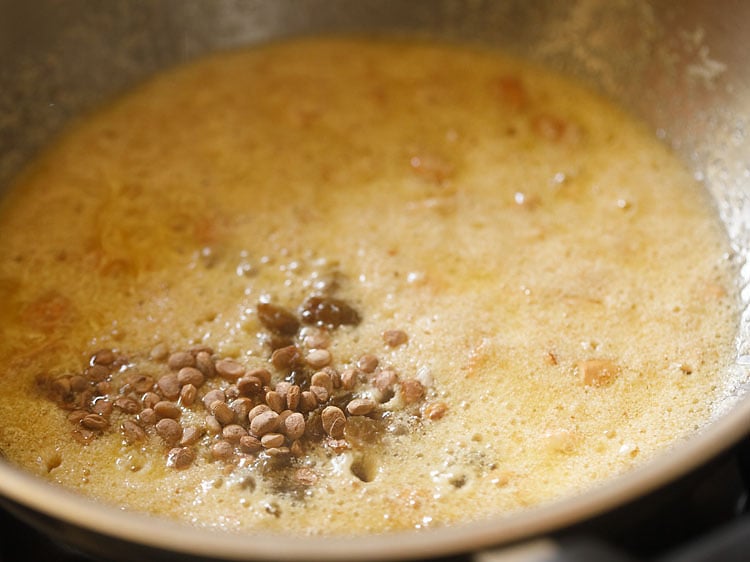
8. Next, add ½ teaspoon cardamom powder (4 to 5 green cardamoms, powdered in a mortar-pestle, husks discarded). You can also add sliced almonds or pistachios.

9. Mix well.
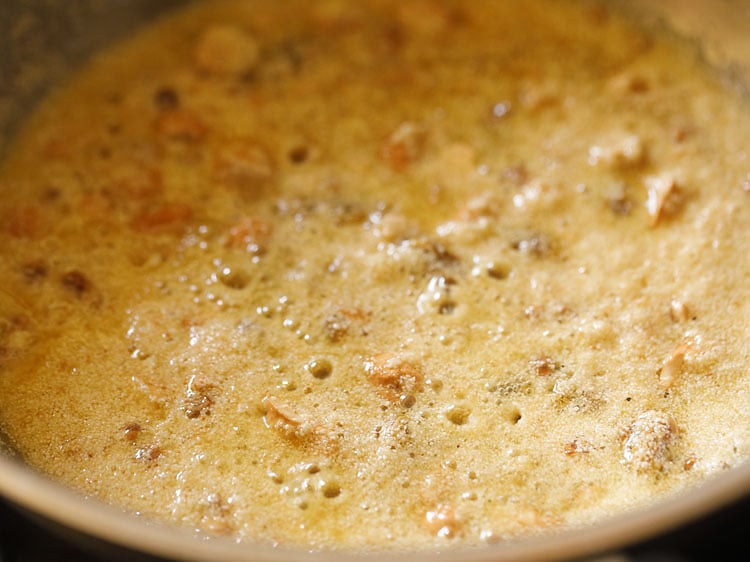
Prepare the Sugar Syrup
10. When you keep the suji for roasting in the ghee, at the same time, take ⅓ cup sugar in another pan or saucepan.
Here, I have used raw sugar and hence the color of the water is not transparent but a light brown. I always use unrefined raw sugar in almost all of my cooking.
Feel free to use white sugar in this halwa recipe. You can add the same amount of white sugar.

11. Pour 1.25 cups water.
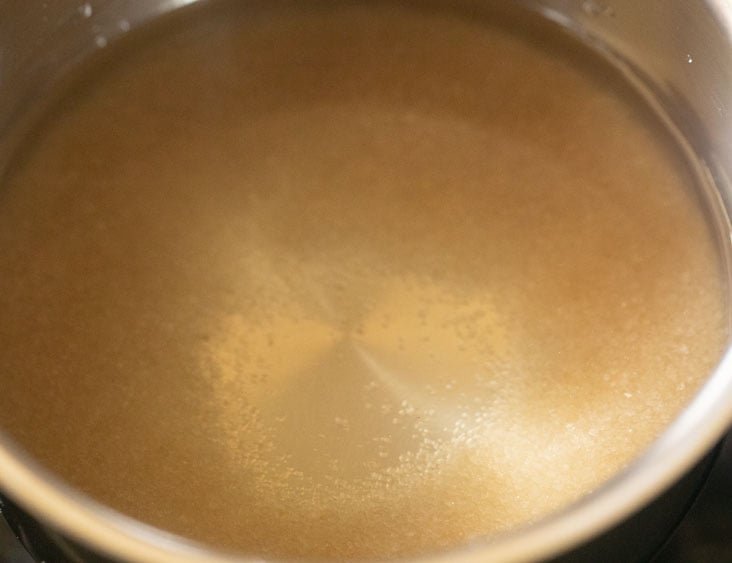
12. Keep the pan on a stovetop on medium-low to medium heat. With a spoon, stir so that the sugar dissolves.
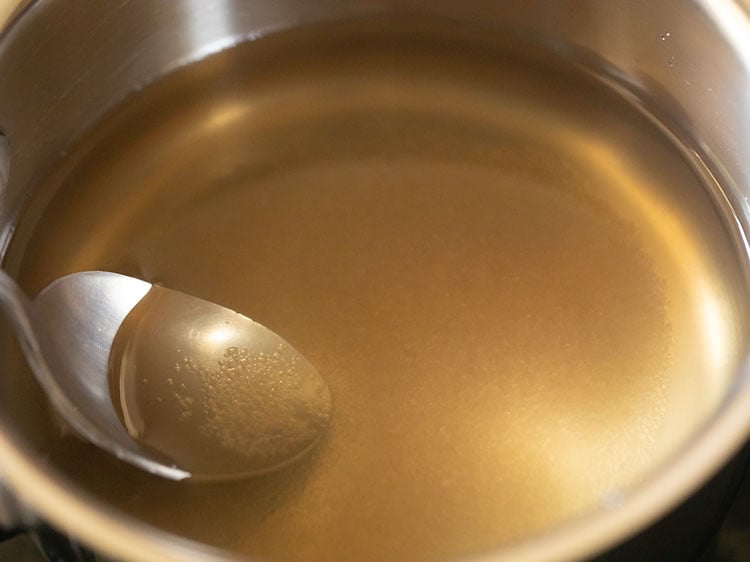
13. Bring the syrup to a boil.

Combine and Cook the Halwa to Perfection
14. Once you stir the raisins, cardamom powder and chironji, pour the boiling sugar syrup slowly in the suji mixture, with continuous stirring.
Pour gently and carefully, as the mixture sizzles and splutters.

15. For a lump-free mixture, stir well. Break the lumps, if any, with a spoon.
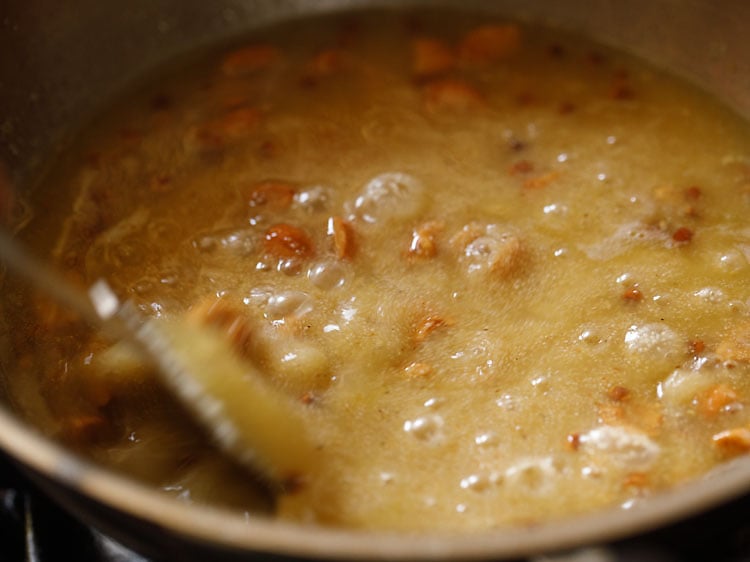
16. The suji grains will begin to absorb the water and swell.
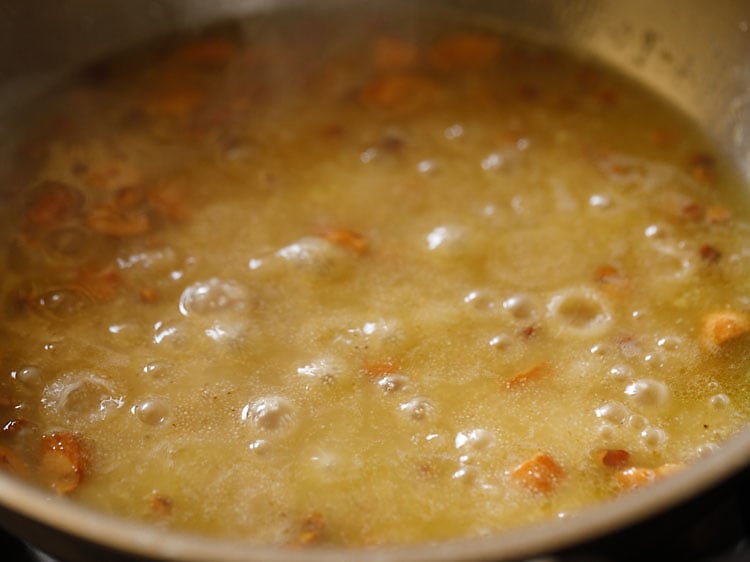
17. The mixture will start thickening. Stir often.
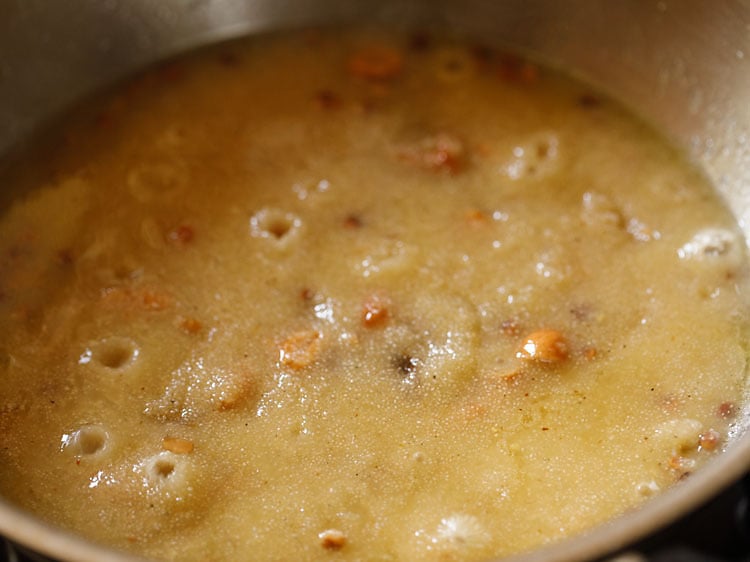
18. In the below picture, the halwa mixture has thickened but still soft, moist and the consistency is like that of pudding.

19. After the mixture absorbs all the water, there will be a change in the texture too. The ghee also will be visible at the sides.

20. Keep stirring and cooking till you get the final texture of the Sheera like the picture below. It should absorb all the water and leave the sides of the pan.
If you want to make slices, cubes or squares, then immediately pour the halwa mixture in a greased pan or tray.
Spread evenly and when warm or cooled, cut into diamond-shaped or square slices.

21. Serve Suji Ka Halwa hot, warm or at the room temperature. You can refrigerate the leftover halwa. Before serving, warm in a small pan or in a microwave.
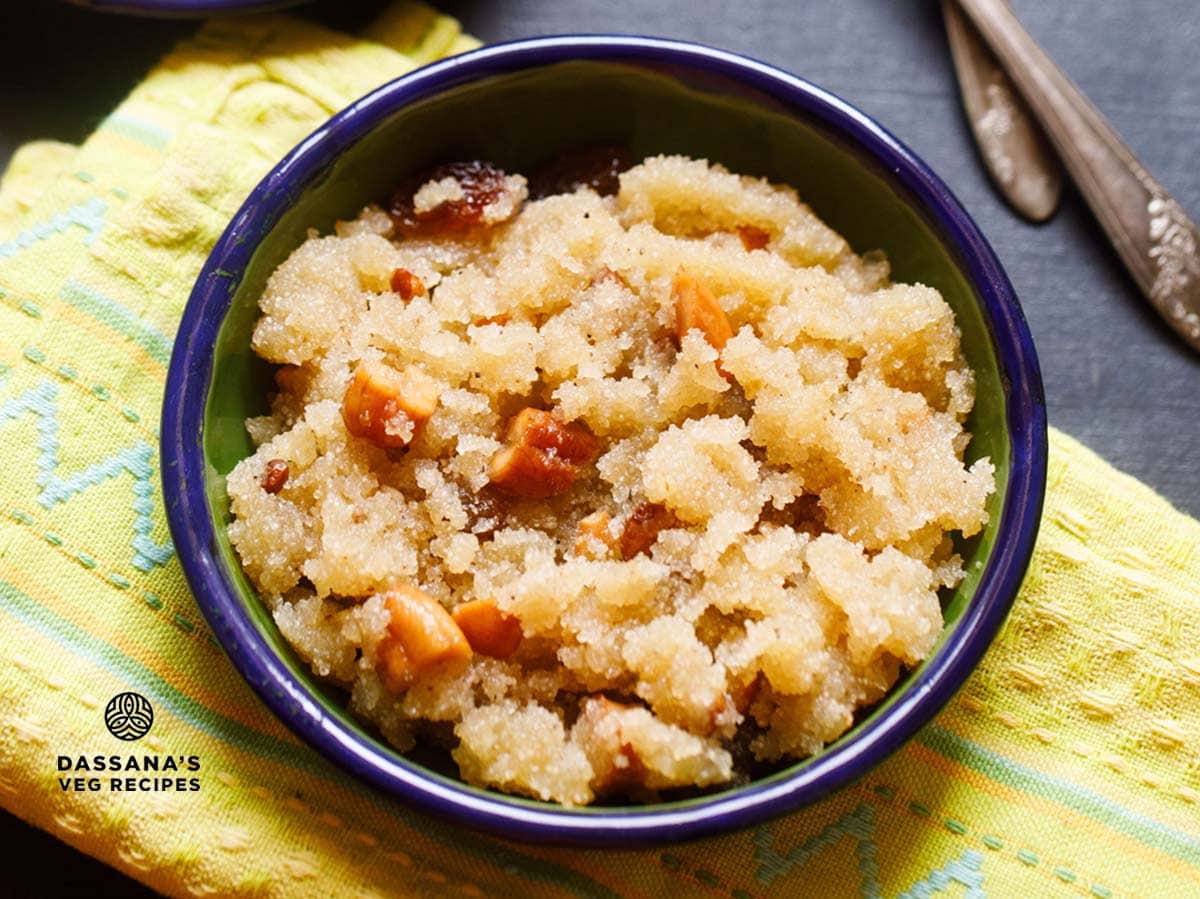
Serving Suggestions
Suji Ka Halwa is incredibly versatile and can be served in different ways depending on the occasion:
- With Puri: A traditional and satisfying combination, especially during poojas or festive brunches.
- As Prasad or Naivedyam: Serve warm in small bowls or leaf cups for temple-style offerings.
- With Kala Chana: During Navratri’s kanjak pooja, halwa is often served with dry kala chana and puri.
- As Dessert: Enjoy it on its own after meals, especially when you’re craving something warm and sweet.
- Tiffin or Snack: Halwa sets well and can be packed in a lunchbox or served as an after-school treat.
Storage & Reheating Tips
Store leftover halwa in an airtight container in the fridge for up to 1 to 2 days. Reheat on a stovetop or in the microwave.
Add a splash of water or milk to loosen the texture if it has thickened or set. Ghee may separate if overheated. Heat gently and stir well.
Secrets to Soft, Flavorful Halwa
- Choose Fine Suji: Use fine suji or Bombay rava for the smoothest texture. Always check that the suji is fresh, free from insects, and not rancid.
- Maintain Proper Temperature: Both the fried suji mixture and the sugar syrup must be hot when combined. The sugar water should be boiling and bubbling. If it cools down, reheat it before mixing.
- Flavoring Options: Classic cardamom powder works beautifully, but you can also add saffron strands soaked in warm water or a splash of rose water for a fragrant twist.
- Sweetener Swaps: You can substitute sugar with jaggery. Dissolve jaggery in warm water, strain to remove impurities, and then bring it to a boil before using.
- Use Milk for Richness: Replace water with milk if you prefer a creamier, richer halwa.
- Nuts & Dry Fruits: Cashews, almonds, golden raisins, chironji, or even pistachios can be added for texture and richness. Fry them in ghee for best flavor.
- Optional Camphor: A pinch of edible camphor adds a divine aroma, especially if you’re preparing the halwa as prasad during Navratri or kanjak pooja.
- Health-Friendly Adjustments: Reduce ghee and sugar to suit your taste or dietary preferences. For a lightly sweet version, start with just ¼ cup sugar per 1 cup suji.
- Parallel Cooking Saves Time: While roasting suji, you can boil the sugar syrup simultaneously on another burner.
- Easily Scalable: This recipe can be halved, doubled, or even tripled for gatherings or festive meals.
Your Questions Answered
Can I make suji halwa with jaggery instead of sugar?
Yes, jaggery is a great substitute. Dissolve it in warm water, strain to remove impurities, and then bring it to a boil before adding it to the roasted suji.
What type of suji works best for halwa?
Use fine suji or Bombay rava for a smooth, soft texture. Coarse suji can make the halwa gritty.
Can I use milk instead of water?
Absolutely. Using milk makes the halwa richer and creamier. You can even try a half-and-half mix of milk and water.
How can I reduce the sweetness or ghee in this recipe?
For a lighter version, use ¼ to ½ cup sugar per 1 cup suji, and reduce ghee as per your preference. The texture and flavor will still be delicious.
More Halwa Recipes You May Enjoy!
If you love Suji Ka Halwa, here are some other traditional sweets you might want to try:
- Atta Halwa – A classic halwa made with whole wheat flour and ghee. Quick, comforting, and great as a post-meal dessert.
- Kada Prasad – The divine whole wheat halwa served in gurudwaras – rich, smooth, and deeply soulful.
- Moong Dal Halwa – Made by slow-roasting ground moong lentils paste in ghee, this halwa is a true festive indulgence.
- Besan Halwa – Nutty and flavorful, prepared with roasted gram flour, ghee, and sugar.
- Badam Halwa – Rich with almonds and saffron, perfect for special occasions like Diwali.
Step by Step Photo Guide Above
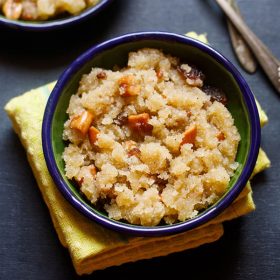
Suji Ka Halwa | Sheera Recipe
Ingredients
- ½ cup suji (fine rava or semolina or cream of wheat)
- ⅓ cup sugar or approximate 5 to 6 tablespoons sugar or add as required
- ⅓ cup Ghee – approximate 6 tablespoons of ghee
- ½ teaspoon cardamom powder – or 4 to 5 green cardamoms powdered in a mortar-pestle, husks discarded
- 10 to 12 cashews – halved or whole (kaju)
- 2 tablespoons golden raisins (kishmish)
- 1 teaspoon chironji – optional (charoli)
- 1.25 cups water – can also add 1 cup water
- 1 pinch edible camphor – optional
Instructions
Preparation
- Crush the green cardamom seeds to a fine powder in a mortar-pestle and keep aside. Remove the husks
- Keep a kadai or pan on a low flame.
- Add the ghee and when the ghee is heating up, do the following.
- Take the sugar and water in another pan.
- Keep this pan on a medium to high heat and let the sugar syrup come to a boil.
- Once the ghee becomes hot, add the suji (semolina) and cashews and stir.
- Keep on stirring the suji (semolina) so that the grains does not stick to the pan and are roasted evenly.
- Meanwhile keep your attention on the sugar syrup also.
- If the mixture starts to boil, then lower the heat and let it simmer.
- Keep on roasting and stirring the semolina for 7 to 8 minutes till the grains change their color and when the cashews also change to a light golden or golden.
- You have to roast sooji till you can see the ghee getting separated. The color of the suji or rava should not become brown. There will also be a fragrant aroma of suji and ghee in your kitchen.
- Remember that the roasting rava is very important. If the rava not is not roasted well then you won't get the best texture in the halwa and there will be slightly raw taste.
- Then add the cardamom powder, chironji, raisins and edible camphor (optional). Mix very well.
Making suji ka halwa or sheera
- Stir and then add the bubbling hot sugar syrup slowly to the roasted suji mixture.
- Be careful as the mixture has the tendency to splutter.
- Be quick enough to stir. The sooji will begin to absorb the water and swell.
- Keep on stirring often till the whole mixture starts thickening and starts to leave the edges of the kadai or pan.
- Serve sooji halwa hot or warm or when cooled at room temperature.
Serving & Storage
- It can be had as a sweet snack or served as a dessert after meals.
- Store any leftovers in the fridge in an air tight container for 1 to 2 days.
- Reheat in a pan before serving. If the mixture has thickened or set, add a splash of water or milk to loosen it. Reheat gently, as overheating may cause the ghee to separate. Stir well before serving.
Video
Notes
- Type of suji: Use the fine variety of suji for making halwa. Ensure that your rava is fresh, within its shelf period and does not have insects or mold and is not rancid.
- Edible camphor: Add a pinch of edible camphor if you are making suji halwa for religious occasions.
- Temperature: When adding the sugar syrup to the rava, it has to be boiling and bubbling hot. If the sugar syrup becomes warm, then heat it up till it comes to a boil. The roasted rava mixture also has to be hot when the sugar syrup is added.
- Multi-cooking: When you begin roasting the rava, at the same time, keep the sugar syrup to boil on another burner.
- Adding less amounts: You can reduce both the amount of sugar and ghee. For less sweet taste in rava sheera, add ¼ cup sugar.
- Sweetener: Jaggery can be also added instead of sugar. First, add jaggery in water and heat the water till it becomes warm. When all the jaggery is dissolved, strain the syrup to get rid of impurities. Put the strained syrup back in the pan and heat till it comes to a boil.
- Liquids: You can add milk instead of water.
- Flavorings & Nuts: You can add your choice of dry fruits and nuts. For flavoring and aroma apart from cardamom powder you can also add saffron strands or even rose water.
- Scaling: Recipe can be halved or doubled or tripled.
Nutrition
Suji Halwa recipe from the blog archives was first published on July 2014.


Can I add dates in this recipe and give the sugar a miss?
Yes, you can definitely add dates and skip the sugar. Just make sure to use soft, seedless dates and chop them finely or blend into a paste for even sweetness. Add them after roasting the suji, along with the water or milk, so they blend well into the halwa. You may need to adjust the quantity depending on how sweet you want it.
I have made Halwa following your recipe so many times and it turns out perfect. I refer to the proportions every single time just to be sure.
This one time I forgot to check and I put 1:1 sooji to sugar ratio and it turned out to be very sweet. Is there any hack to reduce the sweetness once it is prepared?
Thank you Vindhya. Some hot milk or hot water can be added to the halwa. The milk or water will help in cutting down the sweetness. But me mindful when adding so as not to make the consistency runny.
Since the halwa would have been thickened once cooled, in a pan or skillet, add in some hot water or hot milk to the halwa. Keep the heat to a medium-low and gently simmer the halwa. Add some more of the hot water or milk and simmer until you get the right consistency.
The look and feel of the halwa was beautiful. I have not tasted it as yet but I am sure it will be good based on previous recipes picked from here.
Thank you. I hope you like it.
You are my first choice to check for any recipes since many years. All your recipes turn out to be super duper tasty and so foolproof.Though I love experimenting and make recipes since I was a kid, but I still cross check your recipes for measurements be it dhokla, halwa or any snacks recipes. Thank you Dassana.
I have one question dear, is Dassana your website name or is it your name?
Thank you for this lovely feedback and comment. Dassana is my name and is also a part of the website name.
I’ve been following this recipe for years! Works wonders everytime. Thank you Dassana, for teaching me how to cook!
Great and thanks for letting me know. Also thanks for your lovely comment.
One of the few types of halwa I’ve made, this one reminds me of my childhood when all the kids were eating semolina for breakfast. Many hate it since then, but I love it!
Finally I achieved success in making the kind of suji halwa I like. Thank you so much for sharing the recipe!
Welcome and thanks for sharing this lovely feedback.
I am yet to make a recipe from your website that doesn’t taste delicious! Thank you.
Thanks a lot Eva for the lovely comment.
Very good recipe
Thank you.
Turned out really good thanks for those all side note
Which made me understand consistency of water ghee and sugar!
Love this!
Thank you!❤️
Thanks and glad that the tips helped. Thanks for the rating too. Welcome.
Perfect recipe for sooji halwa made it and turned out excellent
thanks mini for the feedback. happy cooking.